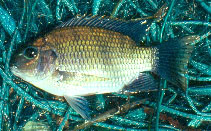| Family: |
Cichlidae (Cichlids), subfamily: Pseudocrenilabrinae |
| Max. size: |
28.3 cm SL (male/unsexed) |
| Environment: |
demersal; freshwater |
| Distribution: |
Africa: coastal areas from the Casamance River (Senegal) to the Saint John River (Liberia) (Ref. 53405). |
| Diagnosis: |
Dorsal spines (total): 16-18; Dorsal soft rays (total): 12-13; Anal spines: 3-3; Anal soft rays: 10-11. Diagnosis: 29-31 total dorsal-fin rays; upper profile of snout strongly arched; head length 31.0-35.0% SL; 30-32 lateral line scales (Ref. 53405). 2 complete rows of scales on cheek (Ref. 2, 53405). Toothed area of lower pharyngeal bone with concave sides; snout and cheek purple; iris orange; nape and upper part of body soiled yellowish; posterior dorsal lappets and upper edge of soft dorsal watery pink; few vague dark spots on soft dorsal and center of caudal; pelvic ending in short white filament (Ref. 2).
Description: outer jaw teeth bicuspid, inner jaw teeth tricuspid, posterior pharyngeal teeth bicuspid; micro-gillrakers present; scales cycloid (Ref. 53405). When adult, deep-bodied with a small mouth (Ref. 52307).
Coloration: young individuals with 7 distinct cross bars on sides and large round "tilapian" spot bordered anteriorly and posteriorly by light-coloured area; cross bars disappear in adults, but "tilapian" spot remains (Ref. 53405). Snout and cheeks purple, nape and back yellowish (Ref. 52307, 53405), fading to white on lower sides and belly (Ref. 53405). Lower lip, lower jaw, preopercle and throat white; posterior area and distal margin of soft part of dorsal fin pink; some black spots on soft part of dorsal and on centre of caudal fin (Ref. 53405). |
| Biology: |
Oviparous (Ref. 205). Ovophilic; mouthbrooder, possibly the male incubates the eggs (Ref. 52307). |
| IUCN Red List Status: |
Least Concern (LC); Date assessed: 13 March 2020 Ref. (130435)
|
| Threat to humans: |
harmless |
Source and more info: www.fishbase.org. For personal, classroom, and other internal use only. Not for publication.

